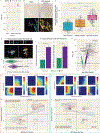Single-Nucleus Transcriptome Profiling of Dorsolateral Prefrontal Cortex: Mechanistic Roles for Neuronal Gene Expression, Including the 17q21.31 Locus, in PTSD Stress Response
- PMID: 37491937
- PMCID: PMC11406458
- DOI: 10.1176/appi.ajp.20220478
Single-Nucleus Transcriptome Profiling of Dorsolateral Prefrontal Cortex: Mechanistic Roles for Neuronal Gene Expression, Including the 17q21.31 Locus, in PTSD Stress Response
Erratum in
-
Correction to Chatzinakos et al.Am J Psychiatry. 2025 Jul 1;182(7):689. doi: 10.1176/appi.ajp.20220478correction. Am J Psychiatry. 2025. PMID: 40589260 No abstract available.
Abstract
Objective: Multidisciplinary studies of posttraumatic stress disorder (PTSD) and major depressive disorder (MDD) implicate the dorsolateral prefrontal cortex (DLPFC) in disease risk and pathophysiology. Postmortem brain studies have relied on bulk-tissue RNA sequencing (RNA-seq), but single-cell RNA-seq is needed to dissect cell-type-specific mechanisms. The authors conducted the first single-nucleus RNA-seq postmortem brain study in PTSD to elucidate disease transcriptomic pathology with cell-type-specific resolution.
Method: Profiling of 32 DLPFC samples from 11 individuals with PTSD, 10 with MDD, and 11 control subjects was conducted (∼415K nuclei; >13K cells per sample). A replication sample included 15 DLPFC samples (∼160K nuclei; >11K cells per sample).
Results: Differential gene expression analyses identified significant single-nucleus RNA-seq differentially expressed genes (snDEGs) in excitatory (EX) and inhibitory (IN) neurons and astrocytes, but not in other cell types or bulk tissue. MDD samples had more false discovery rate-corrected significant snDEGs, and PTSD samples had a greater replication rate. In EX and IN neurons, biological pathways that were differentially enriched in PTSD compared with MDD included glucocorticoid signaling. Furthermore, glucocorticoid signaling in induced pluripotent stem cell (iPSC)-derived cortical neurons demonstrated greater relevance in PTSD and opposite direction of regulation compared with MDD, especially in EX neurons. Many snDEGs were from the 17q21.31 locus and are particularly interesting given causal roles in disease pathogenesis and DLPFC-based neuroimaging (PTSD: ARL17B, LINC02210-CRHR1, and LRRC37A2; MDD: LRRC37A and LRP4), while others were regulated by glucocorticoids in iPSC-derived neurons (PTSD: SLC16A6, TAF1C; MDD: CDH3).
Conclusions: The study findings point to cell-type-specific mechanisms of brain stress response in PTSD and MDD, highlighting the importance of examining cell-type-specific gene expression and indicating promising novel biomarkers and therapeutic targets.
Keywords: Biological Markers; Genetics/Genomics; Glucocorticoid; Major Depressive Disorder; Posttraumatic Stress Disorder; RNA Sequencing.
Conflict of interest statement
Dr. Morrison is currently an employee of Neumora Therapeutics. Dr. McCullough is currently an employee of Jazz Pharmaceuticals. Dr. Carlezon has served as a consultant for PSY Therapeutics. Dr. Krystal has served as a consultant for Aptinyx, Biogen Idec MA, Bionomics (Australia), Boehringer Ingelheim International, Epiodyne, EpiVario, Janssen Research and Development, Jazz Pharmaceuticals, Otsuka America Pharmaceutical, Spring Care, and Sunovion Pharmaceuticals; he has served on scientific advisory boards for Biohaven Pharmaceuticals, BioXcel Therapeutics (clinical advisory board), Cerevel Therapeutics, Delix Therapeutics, Eisai, EpiVario, Jazz Pharmaceuticals, Neumora Therapeutics, Neurocrine Biosciences, Novartis Pharmaceuticals, Psycho-Genics, Takeda Pharmaceuticals, Tempero Bio, and Terran Biosciences; he has been involved in studies that have received medications from AstraZeneca, Cerevel, and Novartis; he is cofounder of Freedom Biosciences; he holds stock in Biohaven Pharmaceuticals, Freedom Biosciences, and Spring Health and stock options in Biohaven Pharmaceuticals Medical Sciences, Cartego Therapeutics, Damona Pharmaceuticals, Delix Therapeutics, EpiVario, Neumora Therapeutics, Rest Therapeutics, Tempero Bio, Terran Biosciences, and Tetricus; he serves as Editor on the editorial board of
Figures





References
-
- Substance Abuse and Mental Health Services Administration: Results From the 2010 National Survey on Drug Use and Health: Summary of National Findings. Rockville, Md, Substance Abuse and Mental Health Services Administration, September 2011. https://www.samhsa.gov/data/sites/default/files/NSDUHNationalFindingsRes...
Publication types
MeSH terms
Substances
Grants and funding
LinkOut - more resources
Full Text Sources
Medical
Miscellaneous

